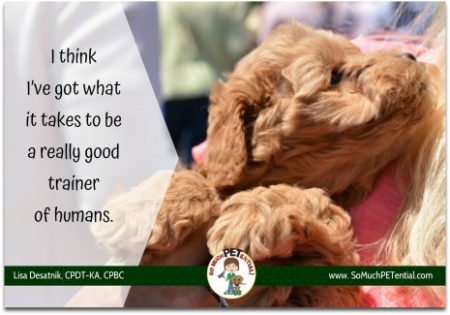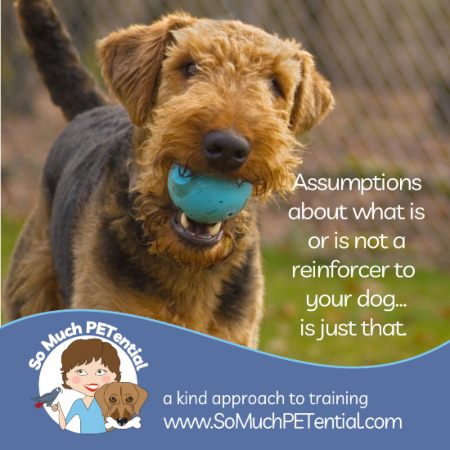Just for fun, kind of/sort of, do you live with a skilled human trainer? I remember once hearing Susan Garrett say that anytime two animals are living together, one is always training the other.
 What exactly does this mean? Well, we all are learning from consequences. It is never all one sided.
What exactly does this mean? Well, we all are learning from consequences. It is never all one sided.
Let’s look at this scenario. If your dog bumps your leg when you are sitting in your couch watching tv, and you respond by talking to your dog, petting it, or getting it a treat, THEN one way of looking at it is that you have just provided your dog with positive reinforcement for bumping your leg. In other words, the immediate consequence of your pet’s behavior is something your dog values and something that has a high likelihood of strengthening the future rate of that behavior.
Applied Behavior is a systematic approach to looking at (and solving) behavior problems in terms of the environment that surrounds it. It involves looking at the very specific behavior (such as a dog bumping a leg) in terms of what is giving that behavior purpose and value? What happened *immediately* prior to the behavior (antecedent) to set the whole ball rolling? And what happened *immediately* after the behavior to reinforce it (consequence)? It is how I have been taught to look at behavior.
In the above case, this could be a simplified functional assessment.
Antecedent: Human sits on couch
Behavior: Dog bumps human’s leg
Consequence: Human gives dog attention, a scratch, or a treat
Looking at it this way, it is easy to see that there is a very good reason your dog has for bumping your let.
But, how then can I say that your dog is training YOU? Let’s reverse this. Remember that behaviors that are followed immediately with something of value TO THE LEARNER, are behaviors you will see more of in the future. What are some potential consequences in this scenario that are of value to you (being the ‘human’), that are maintaining the strength of ‘your’ behaviors? I can venture to guess it could possibly be your dog wags its tail or another behavior that gives you a positive feeling, or it could be that your dog will stop bumping you (temporarily). This is the way that functional assessment would look.
Antecedent: Dog bumps human’s leg
Behavior: Human gives attention to dog or a treat
Consequence: Dog wags its tail or leaves human alone to go eat treat
So, you see, no matter how you look at it, you are both training each other. The key is to understand this learning process and then brainstorm strategies for changing this up so that the behavior you DO NOT like is not being practiced and not being reinforced, while another behavior that is acceptable is taught and reinforced heavily. (Think: instead of bumping your leg when you sit down to watch tv, what you would like for your dog to do instead…then go teach it!)






